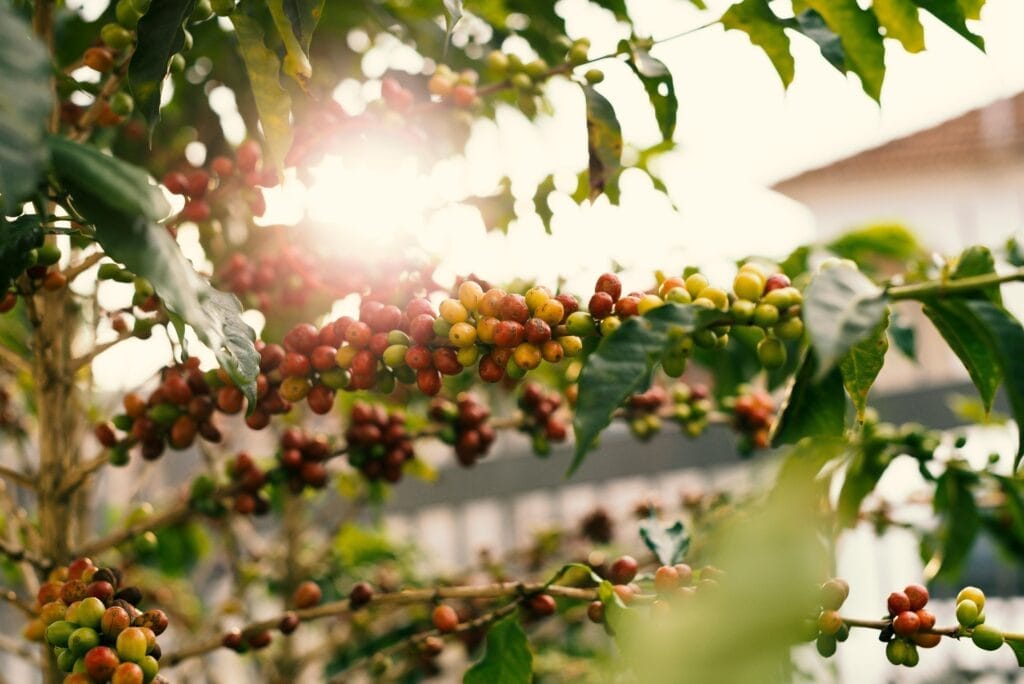
The Rich History of Coffee Cultivation
Coffee farming has a long and storied history, dating back millennia.
The earliest known coffee plants were cultivated in Ethiopia in the 9th century AD, marking the beginning of a global love affair with this aromatic beverage (Cafe Du Monde, 2024).
Since then, coffee bean farming has evolved into a respected profession and a vital industry, supporting millions of livelihoods worldwide.
Understanding the Coffee Plant
Before delving into the intricacies of coffee farming, it’s essential to understand the coffee plant itself.
Coffee plants are shrubs or small trees belonging to the genus Coffea.
The two main species cultivated for commercial purposes are Coffea arabica (Arabica) and Coffea canephora (Robusta) (ISIC, 2024).
Arabica coffee, known for its superior flavor, thrives at higher altitudes and cooler temperatures, while Robusta can withstand harsher conditions and lower elevations.
The Journey Begins: Planting Coffee Seeds
The journey of your morning cup of coffee begins with the planting of a single seed.
Coffee seeds are typically planted in large, shaded nurseries where they are carefully nurtured (National Coffee Association, 2024).
These seedlings require frequent watering and protection from direct sunlight until they are strong enough to be transplanted to the fields.
Farmers often time the planting to coincide with the wet season, ensuring that young plants have ample moisture as they establish their root systems.
Nurturing Young Coffee Plants
Once the seedlings are transplanted, the real work of coffee farming begins.
It takes approximately three to four years for a newly planted coffee tree to bear fruit, requiring patience and dedication from the farmer (Treatt, 2024).
During that time, farmers must carefully manage the plants, providing appropriate nutrients, water, and protection from pests and diseases.
The Art of Shade-Grown Coffee
Many sustainable coffee farms employ a method known as shade-grown coffee cultivation.
This eco-friendly approach involves growing coffee plants under a canopy of trees, mimicking the plant’s natural habitat (Cafe Du Monde, 2024).
Shade-grown coffee produces high-quality beans with richer flavors and lower acidity but also promotes biodiversity by providing habitats for various bird species and other wildlife.
Moreover, this method helps in soil conservation and reduces the need for chemical inputs, making it a win-win for both farmers and the environment.
Water Management in Coffee Farming
Water plays a crucial role in coffee cultivation, and sustainable farmers are increasingly adopting efficient water management practices.
Techniques such as drip irrigation and rainwater harvesting help conserve this precious resource while ensuring optimal plant growth (Cafe Du Monde, 2024).
Additionally, proper water management practices promote soil moisture retention and prevent erosion, contributing to the overall health of the coffee farm ecosystem.
The Importance of Soil Health
Healthy soil is the foundation of successful coffee farming.
Sustainable farmers prioritize soil health through composting, cover cropping, and minimal tillage.
These methods help maintain soil fertility, improve water retention, and support beneficial microorganisms contributing to plant health.
By focusing on the soil’s health, farmers can reduce their reliance on synthetic fertilizers and create a more resilient farming system.
Combating Pests and Diseases
Like all crops, coffee plants are susceptible to various pests and diseases.
Climate change has exacerbated these challenges, with rising temperatures making coffee more vulnerable to pests like the coffee borer and fungal infections such as coffee rust (ISIC, 2024).
Sustainable farmers tackle these issues through integrated pest management strategies, which may include the use of natural predators, resistant plant varieties, and targeted application of organic pesticides when necessary.
The Harvesting Process
The coffee harvest is a critical time in the farming cycle.
Most coffee cherries are harvested by hand, a labor-intensive process that requires skill and experience (National Coffee Association, 2024).
Pickers carefully select only the ripe, red cherries, often returning to the same tree multiple times throughout the harvest season to ensure optimal quality.
In some regions with flat terrain, such as parts of Brazil, mechanical harvesters may be used, but hand-picking remains the norm for most of the world’s coffee production.
Processing Coffee Cherries
Once harvested, coffee cherries must be processed quickly to prevent spoilage.
There are two main methods of processing: the wet method and the dry method.
The wet method, often used for high-quality Arabica beans, involves removing the pulp from the cherry before drying the beans.
The dry method, more common in areas with limited water resources, involves drying the entire cherry before removing the dried pulp (Treatt, 2024).
Each method imparts different characteristics to the final coffee product, influencing its flavor profile and quality.
Sustainable Practices in Coffee Processing
Sustainable coffee farmers are increasingly adopting eco-friendly processing methods.
These may include using water-efficient pulping machines, recycling water used in the wet process, and composting coffee pulp to create organic fertilizer.
Some farms are even experimenting with anaerobic fermentation techniques, which can produce unique flavor profiles while reducing water usage.
Certifications in Sustainable Coffee Farming
Various certifications, such as Fair Trade, Rainforest Alliance, and USDA Organic, play a significant role in promoting sustainable coffee farming practices.
These certifications set standards for environmental stewardship, fair labor practices, and quality control.
By choosing certified coffees, consumers can support farmers who are committed to sustainable and ethical production methods.
Climate Change and Coffee Farming
Climate change poses a significant threat to coffee production worldwide.
Rising temperatures, changing rainfall patterns, and increased pest and disease pressure are challenging coffee farmers’ traditional practices.
In response, many farmers are adapting by planting trees to provide shade, diversifying their crops, and experimenting with drought-resistant coffee varieties.
These efforts are crucial for ensuring the long-term sustainability of coffee farming in the face of a changing climate.
The Economic Impact of Coffee Farming
Coffee farming is a vital economic activity in many developing countries.
According to Fairtrade, around 125 million people worldwide depend on coffee for their livelihoods, with 80% of coffee being produced by 25 million smallholder farmers (Treatt, 2024).
Sustainable coffee farming practices not only benefit the environment but also help ensure the economic stability of these farming communities.
Innovation in Coffee Farming
The coffee industry is constantly evolving, with new technologies and techniques being developed to improve sustainability and quality.
For example, some farms are using drones for precision agriculture, allowing for targeted application of inputs and early detection of pest or disease outbreaks.
Others are experimenting with biochar, a form of charcoal that can improve soil health and sequester carbon.
These innovations demonstrate the coffee industry’s commitment to continuous improvement and sustainability.
The Future of Coffee Farming
As we look to the future, the coffee industry faces both challenges and opportunities.
Climate change, market volatility, and changing consumer preferences will continue to shape the landscape of coffee farming.
However, the growing demand for sustainably produced, high-quality coffee presents opportunities for farmers who are willing to adapt and innovate.
By embracing sustainable practices, leveraging technology, and fostering direct relationships with consumers, coffee farmers can build resilient businesses that thrive in the face of change.
Conclusion: The Complex Journey of Your Coffee
The next time you sip your morning coffee, take a moment to appreciate the complex journey those beans have undergone.
From the careful nurturing of young plants to the meticulous harvesting and processing of ripe cherries, every step in coffee farming requires skill, dedication, and a deep respect for nature.
By supporting sustainable coffee farming practices, we can ensure that this beloved beverage continues to bring joy to millions while also protecting the environment and supporting farming communities around the world.
As consumers, our choices have the power to shape the future of coffee farming, encouraging a more sustainable and equitable industry for all.
References
Cafe Du Monde (2024) The Sustainability In Coffee Bean Farming. Available at: https://www.cafedumonde.co.uk/academie/guides/the-sustainability-in-coffee-bean-farming/ (Accessed: 22 September 2024).
ISIC (2024) Coffee farming. Available at: https://www.coffeeandscience.org/about-coffee/coffee-farming (Accessed: 22 September 2024).
National Coffee Association (2024) 10 Steps from Seed to Cup. Available at: https://www.ncausa.org/About-Coffee/10-Steps-from-Seed-to-Cup (Accessed: 22 September 2024).
Treatt (2024) Journey of the coffee bean: from seed to cup in 9 steps. Available at: https://www.treatt.com/news/the-journey-of-the-coffee-bean (Accessed: 22 September 2024).
Citations
[1] https://www.cafedumonde.co.uk/academie/guides/the-sustainability-in-coffee-bean-farming/
[2] https://www.treatt.com/news/the-journey-of-the-coffee-bean
[3] https://www.ncausa.org/About-Coffee/10-Steps-from-Seed-to-Cup
[4] https://www.coffeeandscience.org/about-coffee/coffee-farming
[5] https://www.britannica.com/topic/coffee-production
[6] https://www.espresso-international.co.uk/coffee-cultivation
[7] https://esquirescoffee.co.uk/news/trends-uk-coffee-shop-industry/
[8] https://www.mintel.com/insights/food-and-drink/the-coffee-and-coffee-shop-industries-what-consumers-want-in-coffee/
Craving new flavours?
Make a Coffee Drink!
Explore our delicious recipes on our blog.


